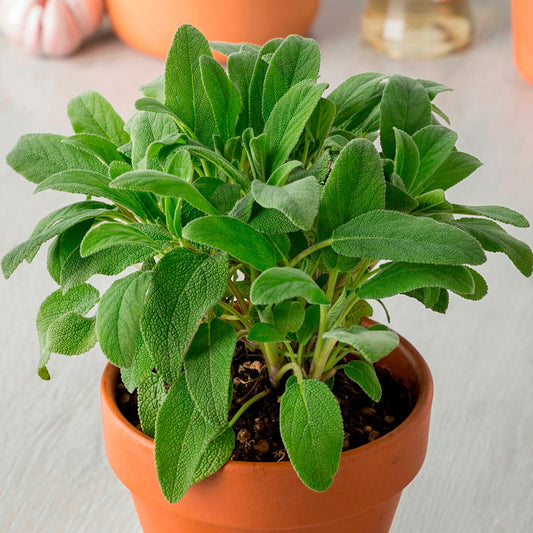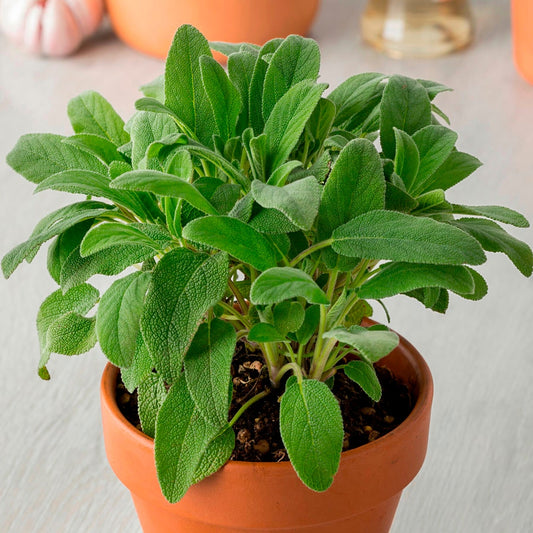Sage Seeds
Discover the perfect addition to your herb garden with our non-GMO sage seeds. Sage is a low-maintenance, easy-to-grow herb that adds rich flavor to any dish. Get your seeds today and start growing fresh, fragrant sage at home!
-
Sage Seeds
Regular price From $3.95Regular priceUnit price / per$3.95Sale price From $3.95 -
Organic Sage Seeds
Regular price $5.95Regular priceUnit price / per$5.95Sale price $5.95
Sage Seeds
What Month Do You Plant Sage?
Planting sage depends on your growing zone. In colder regions (zones 3–6), sow seeds indoors in early spring and transplant them after the last frost. If you’re looking for an easy way to start your sage seedlings indoors, use one of our Bio Domes.
For warmer climates (zones 7–10), you can plant sage seeds directly outdoors from late March to May.
Our sage seeds are suitable for zones 5,6,7, and 8. When you plant your seeds, make sure the soil is well-drained for the best results.
Does Sage Like Full Sun or Shade?
Sage thrives in full sun, requiring at least 6–8 hours of direct sunlight each day. Although it can tolerate partial shade, you'll notice better results with adequate sunlight exposure. These can include stronger growth, more flavorful leaves, and improved resistance to pests.
What Not to Plant Next to Sage
Avoid planting sage near cucumbers, as they may compete for resources and hinder each other’s growth. However, many plants thrive alongside sage, enhancing each other's growth and flavor profiles.
Consider these companions:
-
Rosemary: Both sage and rosemary prefer similar growing conditions, including full sun and well-drained soil, making them ideal partners.
-
Thyme: Thyme helps deter pests and complements sage's growth habits.
-
Carrots: Sage can improve the taste and overall health of carrots, while carrots help aerate the soil.
-
Strawberries: Sage can act as a natural pest deterrent for strawberries, protecting them from slugs and other common threats.
With the right pairings, your sage plants will flourish. These neighboring relationships contribute to a healthy, pest-resistant garden ecosystem.
Does Sage Come Back Every Year?
Yes, sage is a perennial in zones 4–10, returning year after year with proper care. In colder climates, protect your plants with mulch to insulate the roots during harsh winters. Regular pruning also helps maintain healthy, bushy growth.
5 Steps to Grow Your Sage Seeds
Cultivating sage begins with setting a solid foundation for healthy growth. Follow these steps to grow sage plants that are resilient and rich in flavor.
-
Prepare Your Soil: Ensure your soil is loose, well-draining, and slightly alkaline (pH 6.5–7.0) to give your sage seeds the best foundation for growth.
-
Plant Your Seeds: Sow seeds ¼ inch deep, spaced about 12–18 inches apart to allow for mature plant growth and adequate airflow.
-
Water Consistently: Keep the soil moist but not waterlogged while the seeds germinate. Consistent watering supports early root development.
-
Provide Full Sun: As your seedlings grow, ensure they receive at least 6 hours of direct sunlight daily for optimal growth and stronger leaves.
-
Harvest & Maintain: Begin harvesting leaves once the plant is well-established, taking care to trim only ⅓ at a time to encourage continuous growth and vitality.
With the above practices, you’ll set your sage plants up for long-term success. Get everything you need for your herb garden today by exploring our full range of herb seeds and garden supplies!

